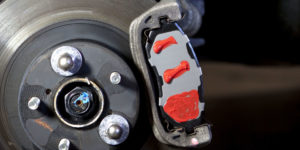
- Check for loose parts.Try wiggling the brake pad, calipers, and other brake components. They should not move with just your hands. Loose parts can vibrate, resulting in noise.
Replace any shims or clips that are loose, damaged or missing to ensure that the pad does not move in the caliper assembly.
Try a dampening paste. Disc Brake Quiet is one brand. Apply a thin layer of the substance to the back of the brake pads (between the pad and the caliper assembly). This will create a thin cushion to dampen the vibration and thereby the sound. Give the paste plenty of time to dry before you assemble the brakes to make sure it hardens: two to three hours at least, overnight if you can. It will become sticky and change to a darker color when it is dry.
Heat from the sun or a hair dryer helps to dry the paste, but let it cool to room temperature before installing the pads.
Should you need to clean or remove the dampening paste, use a degreaser or brake cleaner.
- Check the brake pads, and replace them if they are worn.Many disc brakes include a wear indicator designed to make noise if the pad is worn past a certain point.[2]With aftermarket pads, sometimes the sizes can vary and cause the top of the pad to sit just slightly higher than the rotor. This will result in the brake pad wearing unevenly, leaving a lip or kind of a shelf of brake pad that rides over the tip of the rotor. This causes the brake pad to ride the edge of the rotor, causing a rotational brake noise. If your brake pads still have plenty of life left in them, you can sand the lip of the pad down (make sure you wear a mask to protect your lungs) to get more life out of the existing pads and eliminate the noise.
- Try different brake pad materials.Try different materials, but remember that noise and effectiveness may be a trade-off. It is best to replace brake pads with a similar material. Check the service manual for your vehicle to see what the manufacturer recommends.
- Check the brake rotor or drum for scoring, grooving, or other wear.An irregular brake rotor or drum surface can cause the brake pad to jump and chatter in the brake assembly and caliper.
Check the surface smoothness visually against a comparator gauge or try writing on it with a ball point pen. If you don’t get a smooth line, the rotor is either too greasy or too rough.
- Resurface the rotors.If the rotor wear is not too deep, you may be able to have the rotors ground on a lathe to smooth the surface. Call around to find an auto shop that services brakes and has a rotor lathe. If you do find a shop, ask if they use round lathe bits to refinish as they produce smoother finishes. Additionally you should put a cross-hatch pattern on the newly cut surface using a rotor hone tool, it’s similar to what your do with cylinders bores in an engine block.
- Replace the rotors or drums. If the wear is excessive or if the entire rotor is warped or distorted, you may have to replace the rotors altogether. Brake systems may be carefully designed and “tuned” by the manufacturer to avoid noise, so it is best to choose as close a replacement as possible.
You may also need new rotors if the sound is not a squeal, but a metallic grind. If the brake pads are too worn, the rotors may be damaged.
